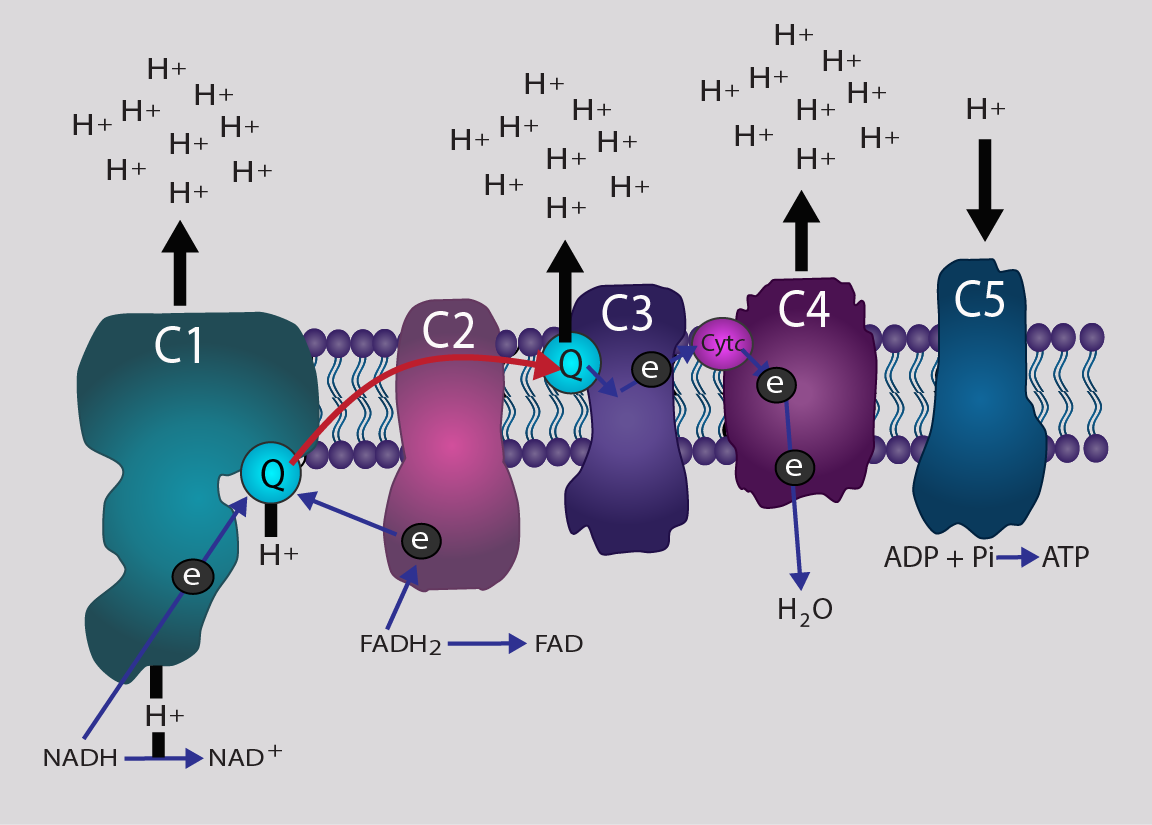Biophysical principle of energy conversion in mitochondria
Comment: could have been better
|
Check of this article is requested. Suggested reviewer: Carmeljcaruana |
Biophysical principle of energy conversion in mitochondria[edit | edit source]
Mitochondria produce adenosine triphosphate or ATP which is the source of energy for cells. ATP is what our cells need for their essential functions that keeps us alive. The process in which the mitochondria forms the ATP is called the electron transport chain. It consists on oxidizing the major products of glucose (a sugar present in all the food we eat): pyruvate, and NADH, which are produced in the cytosol. This process of cellular respiration, also known as aerobic respiration, is dependent on the presence of oxygen.
Description of the process[edit | edit source]
This chain is made up of 4 complexes which are groups of proteins that work together to carry out their function, the 5th complex is responsible for the final step of the ATP generation. They are placed in the inner mitochondrial membrane and parts of the first, third, fourth and fifth complexes are coded for by the mitochondrial DNA. In order for energy to be generated several steps have to occur.

Electrons are passed between the complexes of the electron transport chain and enable the cells to generate energy. The first complex accepts the electrons that are produced from the degradation of the food we eat. As it passes the electrons to the third complex in the chain, protons(H+ ions) are moved across the inner mitochondrial membrane. At complex three the electrons from complex one are joined by others donated by complex two. Complex three passes these electrons onto complex four and in the process moves more protons across the inner mitochondrial membrane. Within complex four the electrons are joined to oxygen to produce water, alongside one final movement of protons. Since so many protons have now been moved across the membrane into the intermembranous space, the amount of H+ is higher on the outside of the membrane, creating a gradient. Complex five (ATP synthase) then uses this gradient to produce ATP through the movement of H+ back into the matrix. For every cycle of the electron transport chain around 30 ATPs are produced.
Importance in clinical medicine[edit | edit source]
- In 1963, researchers discovered that mitochondria have their own DNA different from the one found in the others cells’ nucleus. There are more than 40 different identified diseases that have different genetic feature but all of them make the mitochondria unable to completely process glucose to generate ATP. Therefore, incompletely processed food might accumulate as poison decreasing the reliability of other reactions along the body.
- In newborn infants, there is a large amount of Brown Adipose Tissue in the body. Its main function is to regulate the internal heat - protect the baby from hypothermia (serious problem of premature newborns and a major cause of death) because BAT mitochondria generate energy in the form of heat and do not store it as ATP.
- There are several drugs and toxins that inhibit oxidative phosphorylation. Although any one of these toxins inhibits only one enzyme (complex) in the electron transport chain, inhibition of any step in this process will halt the rest of the process. Here is a diagram with a description of some of them
| Compounds | Use | Site of action | |
|---|---|---|---|
|
Cyanide Carbon monoxide Azide Hydrogen sulfide |
Poisons | Complex IV | |
|
Oligomycin |
Antibiotic | Complex V | |
|
2,4-Dinitrophenol CCCP |
Poisons, weight-loss | Inner membrane | |
|
Rotenone |
Pesticide | Complex I | |
|
Malonate and oxaloacetate |
Poisons | Complex II | |
|
Antimycin A |
Piscicide | Complex III |
Conclusion[edit | edit source]
Mitochondria have the unique function of producing ATP required for living. The process of ATP formation occurs in the mitochondria and it is thus a target for medical research due to some metabolic disorders and also drugs.
References[edit | edit source]
Book
- Molecular Biology of the Cell. 4th edition. Alberts B, Johnson A, Lewis J, et al. New York: Garland Science ; 2002.
Websites


